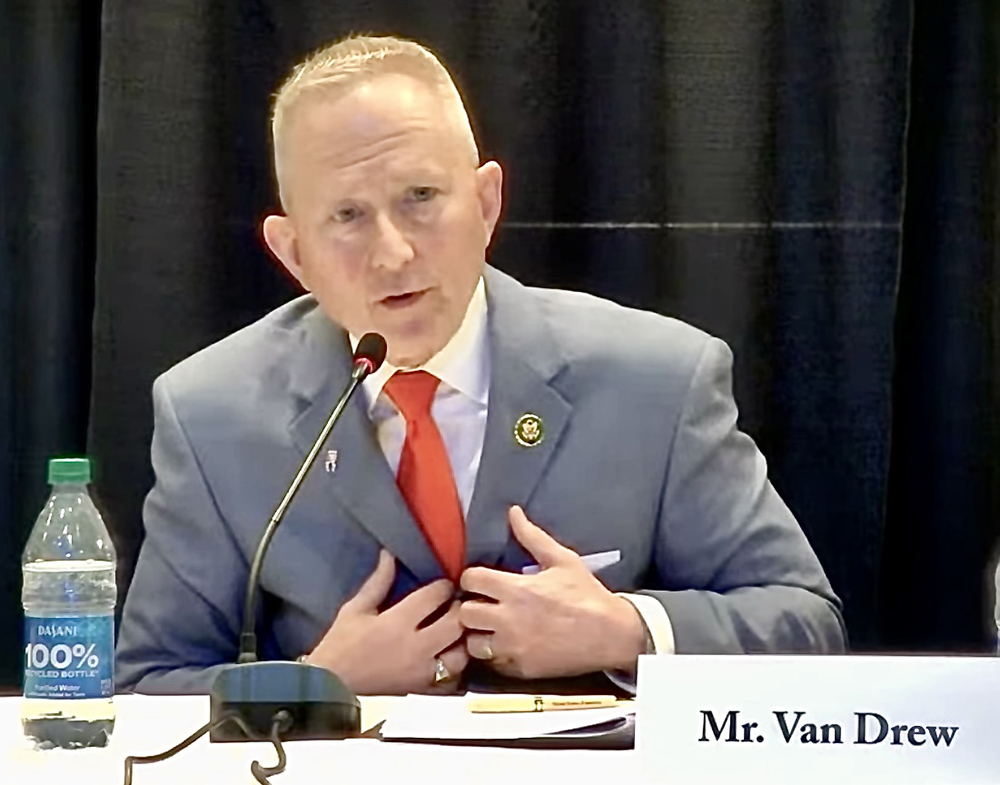By James FitzPatrick
Contributing Writer
Offshore wind came under congressional scrutiny March 16 when Rep. Jeff Van Drew hosted a field hearing in front of an overflow crowd at the Wildwood Convention Center.
Four Republican members of the House of Representatives heard from six experts, all of whom were critical of the offshore wind farms being developed in three lease areas off the New Jersey coast by the federal Bureau of Ocean Energy Management (BOEM), the New Jersey Board of Public Utilities (NJBPU) and the administration of Gov. Phil Murphy.
The hearing was an effort to “develop a legislative solution for the disruptive effect of offshore wind,” Van Drew said.
Marine mammal deaths continue to be the catalyst for offshore wind opposition. Since early December, nine whales have been found dead or dying on New Jersey beaches. Other cetaceans, including porpoises and dolphins, have also been washing ashore at an alarming rate. Counting eight dolphins that stranded on the Sea Isle City beach March 21, that number has reached a combined 23 dead porpoises and dolphins since December according to the Marine Mammal Stranding Center.
Although no official cause of death for the whales has been announced, concerns have been growing that they are connected to sonar mapping of the ocean floor being done in preparation for the construction of the Ocean Wind 1, Ocean Wind 2, and Atlantic Shores offshore wind projects.
Testimony by panelists depicted offshore wind as a threat to more than sea mammals. Tourism, commercial fishing, maritime safety and household budgets are all at risk, according to critics.
“If offshore wind industrialization moves forward, it will be the most profound transformation of the Atlantic coast in the history of the United States of America,” said Van Drew, who has introduced a resolution in the House of Representatives calling for a moratorium on offshore wind until answers to the whale death mystery can be found.
Rep. Chris Smith, from New Jersey’s 4th District (Monmouth and Ocean counties), has introduced a bill in the House seeking an investigation into the environmental approval process for offshore wind projects.
“Like the canary in the coal mine, the recent spate of tragic whale deaths has brought new light and increased scrutiny to the fast tracking of thousands of wind turbines off our coast,” Smith said. He called the wind farm approval process “shotty at best.”
Cindy Zipf, executive director of Clean Ocean Action, agreed that something isn’t right.
“This is too much too fast and in a word simply reckless,” Zipf said. “Marine life is being placed at grave risk without scientific due diligence monitoring and protection to ensure the ocean survives this massive industrialization.”
Despite the magnitude of New Jersey’s offshore wind program, the public, especially those from communities most directly affected, feel like they have no say according to Van Drew, who chaired the meeting.
“From communities to stakeholders, it is hard to find a group that feels as though their thoughts and suggestions have been properly examined and/or addressed by ocean wind companies,” the congressman said.
Van Drew said Orsted, the Danish company which is building Ocean Wind 1 and Ocean Wind 2, was given the opportunity to appear at the hearing, but declined, instead submitting a letter that alludes to what they have already put into the public record.

Between Orsted, the Bureau of Ocean Energy Management, and the Board of Public Utilities, there have been numerous meetings and hearings, virtual and in person, on the offshore wind projects.
Van Drew is not impressed.
“Orsted believes that their current so-called public process has provided a comprehensive record of these projects,” he said, calling the notion “a joke.”
He said taking a stand on offshore wind is not a question of politics.
“All sides have felt some level of unease over these projects,” he said. “It is time we examine the process to guarantee maximum transparency, and fairness when it comes to the implementation of offshore wind and energy.”
Smith said the whale deaths are a warning that something bad is going on. He said there are “numerous, serious questions concerning the extraordinarily harmful environmental impact on marine life and the ecosystems.”
Citing issues of transparency, accountability and potential harm to the coastal environment, the remaining congressmen indicated their concerns.
Rep. Andy Harris, who represents a coastal district in Maryland, said he’s been involved in offshore wind for six years and has been frustrated by the lack of answers available from federal authorities.
“Several years ago I tried to get NOAA (National Oceanic and Atmospheric Administration) to investigate the effects of offshore wind energy on fisheries and marine mammals,” Harris said. “We could have done this years ago, but apparently the federal government didn’t want to do it. The fix was in.”
Federal regulatory agencies have an agenda when it comes to offshore wind, he sad.
Harris, who is a surgeon, was especially concerned about the impact of electromagnetic fields on horseshoe crabs. He noted that horseshoe crabs produce limulus amebocyte lysate (LAL), which is a vital product in safe medical practice.
Rep. Scott Perry from Pennsylvania’s 10th District in south central Pennsylvania, noted that the whale death mystery is getting attention beyond coastal communities.
“The rest of the country is watching; the rest of the world is watching,” Perry said. “There’s a reason these things are happening.”
Zipf, of Clean Ocean Action, outlined the vast scale of offshore wind projects in the pipeline. According to the National Marine Fisheries Service (NMFS), offshore wind power operations will cover up to 2.4 million acres of seafloor with 3,400 turbines requiring 10,000 miles of cable with an additional 5.7 million acres under further consideration by 2030.
According to Zipf, the NMFS has acknowledged that offshore wind poses numerous threats to marine life. Quoting NMFS, she said, offshore wind can “increase ocean noise which can affect behavior of fish, whales and other species; introduce electromagnetic fields that can impact marine life navigation, predator detection, communication and the ability for fish and shellfish to find mates, and change existing habitats by altering local or regional hydrodynamics,” among other things.
She noted an increased risk of vessel strikes, one of the factors often cited in the whale deaths.
“Naturally the National Marine Fisheries Service knows offshore wind is harmful,” she said.
Bob Stern, president of the advocacy group, Save LBI, spoke about noise and the impact on whales and people.
Stern, who has experience overseeing environmental reviews for the Department of Energy, said the disruption in behavior caused by sonic surveying of the ocean floor puts whales in danger.
Whales rely on sound for everything from navigation and communication, to sensing danger (such as ships) and finding food, so disturbing the sound environment is a potential problem. As whales surface to avoid noise, they increase the likelihood of vessel strikes, he said.
Next there will be construction, which includes pile driving over a period of several years to install 50 foot diameter poles.
Once the turbines are in operation, which will be as close as 9 miles off of Long Beach Island, the noise continues as each unit is expected to emit, based on information from the manufacturer Vestas, up to 118 decibels.
He’s concerned that the continuous noise up to 93 miles out could disrupt the migration of the endangered North Atlantic right whale whose migration route has never been known to be closer than 86 miles out.
“You’ve got a whale trying to migrate and encountering this essential wall of noise and obviously it’s putting its migration in jeopardy,” he said.
Van Drew noted that a May 2022 letter obtained through the Freedom of Information Act from NOAA to BOEM warns the wind farms could disturb the migration of the endangered North Atlantic right whale. To date he has seen no official response.
Save LBI hired a private firm to do acoustic studies which concluded that noise will be noticeable on shore, said Stern, noting that sound travels well over open water.
“You’re looking at basically the destruction of the shore experience,” he said.
Michael Donohue, former Superior Court judge and special counsel for Cape County on offshore wind issues, said Orsted acknowledges that Jersey Shore tourism will take a serious hit from offshore wind.
“Information related to Ocean Wind 1 and published on their website indicates that only 85 percent of visitors to the Jersey Shore will return after windmills are installed 15 miles offshore,” Donohue said.
“Cape May County has a $7 billion tourism economy,” he said. “A diminution of 15 percent of tourism, natural and historic resources visitors, according to the Cape May County Department of Tourism, will result in a $993 million decrease in annual total visitor spending in Cape May County.”
He pointed out that a June 2021 amendment to the New Jersey Offshore Wind Economic Development Act that was quickly approved by the Legislature in 10 days, stripped away local authority when it comes to offshore wind projects.
“Any municipality or county in the state of New Jersey that refuses to acquiesce to the demands of a qualified offshore wind project is subject to having their authority as elected officials transferred to the unelected New Jersey Board of Public Utilities,” he said. “Local and county elected officials are pushed aside.”
Daniel LaVecchia, president of LaMonica Fine Foods which is celebrating its 100th anniversary this year, said the Bureau of Ocean Energy Management ignored the concerns of commercial clammers despite being fully aware of what was needed for offshore wind and clamming to co-exist.
Meetings were held with the Bureau of Ocean Energy Management, state agencies and the wind development companies, yet concerns were not taken into account when wind farms were being drawn up, LaVecchia said.
“The clam industry consistently stressed that clam vessels operating mobile, bottom dredges would require a minimum distance between the vertical structures in an array of 2 nautical miles between turbines, placed in straight rows and columns and positioned in line with offshore currents,” LaVecchia said.
Instead the design calls for wind turbines that are 1 nautical mile apart or less.
“When BOEM leased these areas there was no consideration for the commercial fishing industry and our communities that have fished and prospered it in these areas for decades,” he said.
BOEM also failed to account for transit lanes, according to LaVecchia.
“The absence of transit lanes will result in increased fishing and travel times as well as much greater use and cost of fuel.”
LaVecchia said less product will be landed at the docks resulting in less income for fishermen, less productivity at the plants and possibly the loss of commercial clamming off of New Jersey.
Meghan Lapp, fisheries liaison for Rhode Island-based Seafreeze Shoreside Inc., said the Bureau of Ocean Energy Management is more interested in promoting wind energy development than protecting fisheries and mariners.
The nation’s first Atlantic Ocean wind farm, built by Orsted less than 4 miles off of Block Island, R.I., began operations in late 2016 with five turbines and 30 megawatts of capacity.
According to Lapp, BOEM has leased 28 locations so far with plans for many more.
Lapp said she has been working with BOEM since 2016 to get the agency to address fishing concerns. But instead wind farm lease areas have been located in important fishing and transit routes. She said BOEM documents acknowledge that some fishing grounds will be abandoned due to navigational issues.
Lapp said there has been a dearth of research and analysis and communication on what impact having hundreds of wind turbines spaced a mile apart will have on vessel navigation and radar, especially in bad weather and Coast Guard search and rescue operations.
“The fact is that search and rescue, a core mission of the United States Coast Guard, will be compromised without any analysis on what this will mean for U.S. mariners,” she said. “BOEM’s response has been to approve projects anyway leaving analysis and solutions to developers after construction, despite a legislative mandate to provide for safety.
“The reality is that nobody in the U.S. Government is at the helm, or actually critically regulating any of this activity,” she said. “There is no independent analysis occurring. There is no oversight in what appears to be a textbook definition of regulatory capture.
“In reality and in practice the offshore wind developers are at the helm.”
David Stevenson, director of the Center for Energy Competitiveness for the Caesar Rodney Institute, said offshore wind is going to jack up electric bills for New Jersey residents.
The three projects now in the pipeline will add about $100 more in electricity costs per year for average New Jersey households, according to data from the New Jersey Board of Public Utilities, Stevenson said.
“If you add that up over 20 years, which is the project life, you’re talking about a $2,000 commitment from every household,” he said. The additional cost comes to $6,000 if the state’s total offshore wind energy plan is built out, and that does not account for eventual decommissioning costs.
He also predicted that the cost paid for the electricity to the wind generating companies will rise as new price contracts are negotiated.
“It is likely that 97 percent of the approved project capacity on the entire East Coast is priced too low to attract financing to get these things built, and a number of the developers are already asking for more money from the utility commissions and state governments up and down the coast,” he said.
Stevenson believes that if the goal is green energy and reduced greenhouse gas emissions, we should start over with other technologies such as solar, carbon capture and small scale nuclear, which is being developed now by a company in Camden.
“Ocean wind is the most expensive choice to reduce carbon dioxide emissions from the electric grid,” he said, calling offshore wind “an environmental, wrecking ball.”
“Do New Jersey families really want to pay $2,000 or $6,000 to subsidize offshore wind that will spoil the beautiful Jersey Shore and the environment when better solutions exist?
Rep. Smith said the work is being rushed so companies can qualify for federal tax incentives. He said offshore wind companies get a 30 percent tax credit for projects that begin construction by Jan. 1, 2026.
“So they’re saying the heck with all the environmental reviews, we want to get that money, we want to build these things and we want to do it now,” he said.
Smith said his legislation will call on the Government Accountability Office to examine how the environmental reviews are done.
Copyeditor and Contributing Writer James FitzPatrick has been a community journalist in Atlantic and Cape May counties for more than 30 years, including 20 years as editor of The Current Newspapers. He lives in Hammonton.










